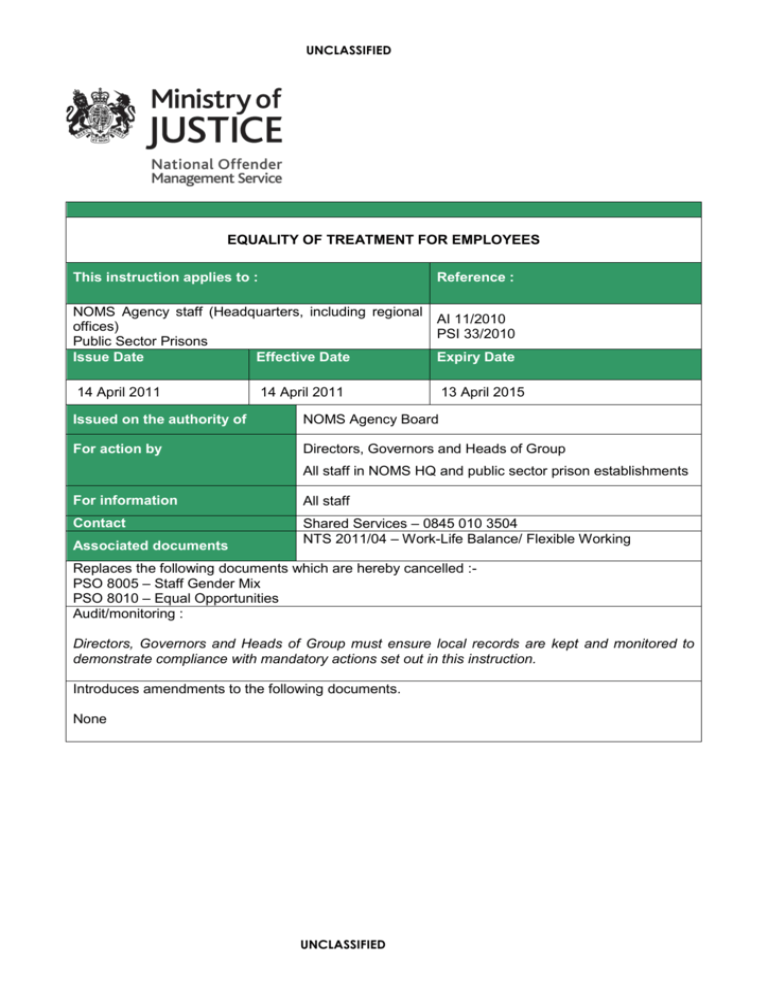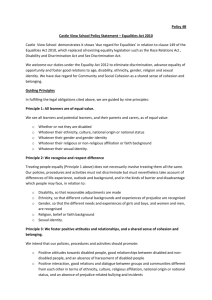
UNCLASSIFIED
EQUALITY OF TREATMENT FOR EMPLOYEES
This instruction applies to :
Reference :
NOMS Agency staff (Headquarters, including regional
AI 11/2010
offices)
PSI 33/2010
Public Sector Prisons
Issue Date
Effective Date
Expiry Date
Implementation date
14 April 2011
14 April 2011
13 April 2015
Issued on the authority of
NOMS Agency Board
For action by
Directors, Governors and Heads of Group
All staff in NOMS HQ and public sector prison establishments
For information
All staff
Contact
Shared Services – 0845 010 3504
NTS 2011/04 – Work-Life Balance/ Flexible Working
Associated documents
Replaces the following documents which are hereby cancelled :PSO 8005 – Staff Gender Mix
PSO 8010 – Equal Opportunities
Audit/monitoring :
Directors, Governors and Heads of Group must ensure local records are kept and monitored to
demonstrate compliance with mandatory actions set out in this instruction.
Introduces amendments to the following documents.
None
UNCLASSIFIED
UNCLASSIFIED
Page 1
CONTENTS
Section
Subject
Applies to
1
Executive summary
All staff
2
Policy
All staff
3
Management
Directors, Governors and HoGs
4
Monitoring
All staff
5
Equality Impact Assessments
Directors, Governors, HoGs and HQ
Policy leads
6
Disabled Employees
Managers, disabled staff
7
Transsexual / Transgender Employees
Managers and SSC staff
8
Positive Action
Directors, Governors, HoGs and
Managers
9
Occupational Requirements
Directors, Governors, HoGs and
Managers
Annex A
Annex B
Annex C
Legal responsibilities
‘Two Ticks’ scheme
Occupational Requirements
PSI 33/2011-AI 11/2011
UNCLASSIFIED
Issue date 14/04/2011
UNCLASSIFIED
1
Page 2
Executive summary
Background
1.1
This Instruction sets out the policy and mandatory actions for ensuring equality of treatment
for staff in NOMS HQ and public sector prison establishments. It replaces the previous
policy documents and associated guidance.
1.2
The Instruction has been updated to reflect changes to the HR Operating Model. For this
reason, information on many of the processes through which equality is ensured that were
covered in the previous policy document is now to be found on the Equalities Group
intranet site.
1.3
The main document is purposefully brief and contains links to comprehensive guidance
material which will be updated as necessary to reflect the legislative position and best
practice.
Desired outcomes
1.4
This instruction aims to ensure that:
we meet our obligations under equality legislation; and
systems are in place to identify and manage staff equalities issues.
Application
1.5
All staff must read and follow sections of this policy as required.
Mandatory actions
1.6
Italicised sections within this Instruction give particular emphasis to the mandatory actions.
All levels of management and all employees must ensure that they are aware of these
mandatory actions and ensure this policy is implemented and adhered to.
Resource Impact
1.7
There will be no direct resource impact on NOMS headquarters or prison establishments
resulting from this Instruction as there has been no fundamental change to existing policy.
(signed)
Phil Copple
Director of National Operational Services
PSI 33/2011-AI 11/2011
UNCLASSIFIED
Issue date 14/04/2011
UNCLASSIFIED
2
Page 3
Policy
NOMS Equality Policy Statement
2.1
NOMS is committed to fairness for all. We treat our staff properly and ensure equality of
opportunity. We deliver our services fairly and respond to individual needs. We insist on
respectful and decent behaviour from staff, offenders and others with whom we work. We
recognise that discrimination, harassment and bullying can nevertheless occur and we take
prompt and appropriate action whenever we discover them.
2.2
In support of this policy statement the NOMS Agency Board has issued a statement about
inappropriate behaviour at work (available on the Equalities Group intranet site or from
Equalities.Group@noms.gsi.gov.uk).
2.3
As a public authority, it is unlawful for NOMS in the exercise of its public function to do
anything that constitutes discrimination, harassment or victimisation in relation to certain
protected characteristics. As a public authority NOMS is also obliged to consider the need
to eliminate unlawful discrimination, harassment and victimisation and advance equality of
opportunity between people from different groups and foster good relations between people
from different groups. For more information please see AI 10/2011 – PSI 32/2011 Ensuring
Equality.
2.4
This Instruction deals with NOMS’ duties as an employer in relation to staff and equality of
treatment for staff. As an employer, NOMS is required not to discriminate against, harass
or victimise an employee or conduct itself in a way that is prohibited by the Equality Act
2010. As an employer NOMS needs also to consider the need to eliminate unlawful
discrimination and to promote equality of opportunity and good working relationships
between all staff.
2.4
All members of staff must work and behave in a way that is consistent with the equality
policy statement and our legal responsibilities (see annex A) to eliminate discrimination and
to promote equality and good relations.
2.5
The legal responsibilities of staff in terms of eliminating discrimination and promoting
equality and good relations are set out in AI 10/2011 – PSI 32/2011 Ensuring Equality, and
the Professional Standards Statement at paragraph 3.2 of AI 05/2010 - PSI 06/2010
Conduct and Discipline sets out behavioural expectations in detail.
Challenging Inappropriate Behaviour
2.6
Inappropriate behaviour will not be tolerated. All allegations will be treated seriously and
confidentially
2.7
Staff who feel able to do so should challenge the perpetrator and ask them to stop, using
the methods set out in the Challenge It, Change It guidance (available on the Equalities
Group intranet site or from Equalities.Group@noms.gsi.gov.uk).
2.8
Staff do not have to deal with inappropriate behaviour on their own and there are a number
of sources of support, identified at the end of the Challenge It, Change It guidance.
2.9
Staff must formally report persistent or serious inappropriate behaviour. PSO 8550 Staff
Grievance or PSI 09/2010 - AI 07/2010 Reporting Wrongdoing procedures should be used
as appropriate.
PSI 33/2011-AI 11/2011
UNCLASSIFIED
Issue date 14/04/2011
UNCLASSIFIED
Page 4
3
Management
3.1
Directors (in HQ and regional offices), Governors (in establishments) and Heads of Group
(HoGs) must ensure that staff are aware of their equalities responsibilities (see Annex A).
3.2
Directors, Governors and HoGs must ensure that management information on equalities
issues in regard to staff is analysed, and that a local equality action plan is produced and
published. Responsibility for actions on the plan must be clear and managers and staff
must be held to account for progress through relevant management checks. Progress must
be tracked and an update report must be submitted regularly for discussion by the Senior
Management Team.
3.3
The plan must include a programme of activities to foster good relations between
different staff groups and to promote and celebrate diversity within the establishment/group.
3.4
Directors, Governors and HoGs must ensure that staff and other stakeholders,
particularly those from minority groups, are consulted and involved appropriately.
4
Monitoring
4.1
NOMS collects monitoring data on all protected characteristics from staff and uses it to
identify actions to ensure fairness for all.
4.2
All staff are encouraged to complete and update their equality monitoring information. More
detailed guidance and a walk through example can be found on the Equalities Group
intranet site or obtained from equalities.group@noms.gsi.gov.uk
5
Equality Impact Assessments
5.1
Equality impact assessments provide a systematic way of ensuring that our policies are
formulated and implemented in a fair way in accordance with our legal obligations.
5.2
National HR policies must be subject to equality impact assessments in accordance with the
arrangements set out in AI 10/ 2011.
5.3
Where evidence or risk of differential impact of a particular policy or practice is identified at
establishment level, consideration must be given to conducting a local impact assessment
in accordance with the arrangements set out in PSI 32/2011.
6
Disabled Employees
6.1
Disabled employees are encouraged to disclose their status to their line manager and/or to
the Shared Service Centre. This information will be treated confidentially (see guidance on
the Equalities Group intranet site or available from equalities.group@noms.gsi.gov.uk.
6.2
Managers must consider whether policies and practices, the built environment, or a lack of
auxiliary aids and services are putting a disabled employee at a substantial disadvantage
when compared to a non disabled employee and if so must make reasonable adjustments
to avoid the disadvantage. This duty is ongoing.
6.3
All requests for reasonable adjustments must be considered and the outcome documented.
6.4
More detailed guidance on reasonable adjustments can be found on the Equalities Group
intranet site or obtained from equalities.group@noms.gsi.gov.uk
PSI 33/2011-AI 11/2011
UNCLASSIFIED
Issue date 14/04/2011
UNCLASSIFIED
Page 5
‘Two Ticks’ scheme
6.5
As an employer using the disability symbol (annex B) NOMS has made commitments
regarding recruitment, training, retention, consultation and disability awareness which
include the following:
to interview all disabled applicants who meet the minimum criteria for a job vacancy
and to consider them on their abilities
to discuss with disabled employees, at any time but at least once a year, what both
parties can do to make sure disabled employees can develop and use their abilities
to make every effort when employees become disabled to make sure they stay in
employment
6.6
Those involved in the recruitment, selection and management of applicants and employees
must ensure they comply with the requirement the ‘Two ticks’ scheme (annex B)
7
Transsexual / Transgender Employees
7.1
In order to ensure fair and sensitive treatment of employees who propose to undergo, are
undergoing or have undergone a process or part of a process for the purpose of
reassigning their sex by changing physiological or other attributes of sex, guidance for
managers and staff is available on My Services.
7.2
More detailed guidance on terminology and definitions can be found on the Equalities
Group intranet site or obtained from equalities.group@noms.gsi.gov.uk
8
Positive Action
8.1
Employers are permitted to take positive action measures to improve equality for people
who share a protected characteristic. Positive action is not positive discrimination which
is unlawful except in specific circumstances.
8.2
Positive action measures can only be taken if the employer reasonably thinks that
persons who share a protected characteristic suffer a disadvantage connected to that
characteristic; or that persons who share a protected characteristic have different needs
to those who do not share it; or that participation in an activity by persons who share a
protected characteristic is disproportionately low. If so, the employer can take any action
which is a proportionate means of achieving the aim of enabling or encouraging those
persons to overcome or minimise that disadvantage; or meeting the different needs; or
enabling or encouraging those persons to participate in that activity. Positive action can
include providing training opportunities to the target group, or providing mentoring and
support where the need is identified, or taking action to assist under represented groups
to compete for promotion (where selection decisions continue to be made on merit).
8.3
The use of positive action measures must be approved locally by a Director, Governor or
Head of Group.
9
Occupational Requirements
9.1
There are some occasions when there is a requirement to employ a member of a particular
group. This is known as an occupational requirement (Annex C)_Annex_J_-. This can apply
to particular posts (e.g. a Chaplain of a particular religion) or because there is a need to
PSI 33/2011-AI 11/2011
UNCLASSIFIED
Issue date 14/04/2011
UNCLASSIFIED
Page 6
ensure there are sufficient employees from a particular group to conduct specific duties
(e.g. sufficient female employees to conduct searches of female visitors).
9.2
The use of an occupational requirement must be approved locally by the Director, Governor
or the Head of Group.
PSI 33/2011-AI 11/2011
UNCLASSIFIED
Issue date 14/04/2011
UNCLASSIFIED
Page 7
Annex A – Legal Responsibilities
Introduction
A.1.
This guidance sets out the characteristics of a person that are protected by the Equality Act
2010 and the conduct that is not allowed in relation to these characteristics, and explains
the duties which the Act imposes on NOMS. More detailed guidance and some examples
can be found on the Equalities Group intranet site or obtained from
equalities.group@noms.gsi.gov.uk
A.2.
Where employees feel they are not being treated fairly in accordance with Service’s legal
responsibilities, they should raise their concerns with their line manager or use the
processes outlined under “Challenging Inappropriate Behaviour” at 2.6 – 2.9 of this
instruction.
Protected characteristics
A.3.
For something to be illegal under the Act it must relate to a protected characteristic. These
are described below.
Age
A.4.
This refers to a particular age group, whether this is a particular age or a range of ages.
Disability
A.5.
This covers people who have or have had a physical or mental difficulty which has a
substantial and long-term negative effect on their ability to carry out normal day-to-day
activities, or would have such an effect if measures were not being taken to treat or control
the difficulty.
Gender reassignment
A.6.
This covers people who propose to undergo, are undergoing or have undergone a process
or part of a process for the purpose of reassigning their sex by changing physiological or
other attributes of sex. The process is a personal one not a medical one; it is not necessary
for the person to be undergoing medical treatment.
Marriage and civil partnership
A.7.
This covers people who are either married or in a civil partnership.
Pregnancy and maternity
A.8.
This means a woman during her ‘protected period’, i.e. from the start of her pregnancy to
the end of her additional maternity leave, or when she returns to work after the pregnancy,
if that is earlier.
Race
A.9.
A racial group is a group of persons who are defined by reference to race. Race includes
colour, nationality and ethnic or national origins.
Religion or belief
PSI 33/2011-AI 11/2011
UNCLASSIFIED
Issue date 14/04/2011
UNCLASSIFIED
Page 8
A.10. This includes any religion, religious belief or philosophical belief. It also includes any lack of
religion, religious belief or philosophical belief.
Sex
A.11. This covers men and women.
Sexual orientation
A.12. This means a person’s sexual orientation: whether that person’s sexual orientation is
towards persons of the same sex, persons of the opposite sex, or persons of either sex.
Prohibited conduct
A.13. As an employer it is illegal for NOMS to discriminate unlawfully against, or victimise an
employee as to the terms of employment; in the way access is provided to opportunities for
promotion, transfer or training, or for receiving any other benefit, facility or service; by
dismissing an employee; or by subjecting an employee to any other detriment. In addition it
is illegal for NOMS to harass an employee. Discrimination, harassment and victimisation
are as defined below.
Direct discrimination
A.14. This is where someone treats another person less favourably than others because of a
protected characteristic. Direct discrimination can occur when a person is treated less
favourably because that person is linked or associated with someone who has a protected
characteristic. It can also occur where a person is treated less favourably because it is
wrongly thought that the person has a particular protected characteristic or is treated as if
that person does. It should be noted that in relation to age direct discrimination can be
justified as a proportionate means of achieving a legitimate aim.
Indirect discrimination
A.15. This is where a rule or policy is applied to everybody but would put people with a relevant
protected characteristic at a particular disadvantage. However, there is no discrimination if
the rule or policy can be justified as a proportionate means of achieving a legitimate aim.
Discrimination arising from disability
A.16. This is a particular form of discrimination where someone treats another person less
favourably because of something arising in consequence of their disability. However, there
is no discrimination if the treatment can be justified as a proportionate means of achieving a
legitimate aim.
Pregnancy and maternity discrimination: work cases
A.17
This is where someone treats a woman unfavourably because of her pregnancy or an
illness suffered by her as a result; or because she is on compulsory maternity leave; or
because she is exercising or is seeking to exercise, or has exercised or has sought to
exercise, the right to ordinary or additional maternity leave.
Gender reassignment discrimination: cases of absence from work
A.18
This is where some treats a person less favourably in relation to an absence from work that
is because of gender reassignment.
Harassment
PSI 33/2011-AI 11/2011
UNCLASSIFIED
Issue date 14/04/2011
UNCLASSIFIED
A.19
Page 9
This is where unwanted conduct related to a relevant protected characteristic (or unwanted
conduct of a sexual nature) has the purpose or effect of violating another person’s dignity or
creates an intimidating, hostile, degrading, humiliating or offensive environment for another
person. It also constitutes harassment if, following rejection of or submission to unwanted
conduct of a sexual nature or unwanted conduct related to gender reassignment or sex, a
person is treated less favourably. Additionally, if a third party is harassing an employee and
reasonable steps are not taken to prevent it, the employer may be liable for the
harassment.
Victimisation
A.20
This is where someone is subjected to a detriment because that person does a protected
act, or it is believed that that person has done, or may do, a protected act. A protected act
means bringing proceedings under the Equality Act 2010, giving evidence or information in
connection with proceedings under the Act, doing any other thing for the purposes of or in
connection with the Act and making an allegation that someone has contravened the Act.
However, people who give false evidence or information, or make a false allegation, are not
protected from victimisation if they have done so in bad faith.
Duties
A.21. The Act imposes an additional duty on NOMS as a public authority, which impact on
NOMS’ treatment of staff as an employer. The duty is to have due regard to the need to:
Eliminate unlawful discrimination, harassment and victimisation
A.22. Unlawful discrimination, harassment and victimisation should be eliminated.
Provide equal opportunities
A.23. Staff and others with whom we work should be provided with equal opportunities. This can
be done in a number of ways:
Removing or minimising disadvantages suffered by people who share a relevant
protected characteristic that are connected to that characteristic.
Taking steps to meet the needs of people who share a relevant protected
characteristic that are different from the needs of people who do not share it.
Encouraging people who share a relevant protected characteristic to participate in
any activity in which participation by such people is disproportionately low.
Foster good relations
A.24. Good relations between people with a protected characteristic and people without that
protected characteristic should be fostered, in particular through tackling prejudice and
promoting understanding.
Further information
A.25. Further information on the Act can be found on the following websites:
www.equalities.gov.uk
Government Equalities Office
www.equalityhumanrights.com
Equality and Human Rights Commission
PSI 33/2011-AI 11/2011
UNCLASSIFIED
Issue date 14/04/2011
UNCLASSIFIED
Page 10
A.26. If you have any questions which are not covered in this guidance please contact the
Equalities Group.
Telephone:
0300 047 5005
E mail:
equalities.group@noms.gsi.gov.uk
Mail:
3.16 Clive House
70 Petty France
London
SW1H 9HD
PSI 33/2011-AI 11/2011
UNCLASSIFIED
Issue date 14/04/2011
UNCLASSIFIED
Page 11
Annex B - ‘Two Ticks’ scheme
B.1 As an employer using the disability symbol NOMS has made five commitments regarding
recruitment, training, retention, consultation and disability awareness:
to interview all disabled applicants who meet the minimum criteria for a job vacancy
and to consider them on their abilities
to discuss with disabled employees, at any time but at least once a year, what both
parties can do to make sure disabled employees can develop and use their abilities
to make every effort when employees become disabled to make sure they stay in
employment
to take action to ensure that all employees develop the appropriate level of disability
awareness needed to make these commitments work
to review these commitments each year and assess what has been achieved, plan
ways to improve on them and let employees know about progress and future plans
Why did NOMS Become a Symbol User?
B.2 Using the symbol helps us to demonstrate that NOMS is serious about ensuring employment
opportunities for disabled people. Job applicants and existing staff will be judged on the basis
of their abilities rather than on stereotypical assumptions.
B.3 By encouraging disabled people to apply for posts in the Service we hope to achieve a more
representative proportion of disabled people in the work force.
B.4 By ensuring that disabled people are given opportunities for development we can make sure
that disabled employees have the same opportunities as others to make the best use of their
abilities.
B.5
By making every effort to retain disabled employees we can make sure that we do not lose
valuable experience and expertise unnecessarily.
How does the GIS Work?
B.6 NOMS started using the GIS from 1 January 1996. Under the commitment any disabled
person who meets the minimum criteria for a grade and/or post is guaranteed an interview.
B.7 Selection for posts will continue to be solely on merit and, at the interview itself, disabled
candidates applying under the scheme will compete without advantage against other
candidates.
B.8 For the purposes of the scheme disability is defined as a physical or mental impairment which
has a substantial and long-term adverse effect on the applicant’s ability to carry out normal
day-to-day activities. Giving false information about this may invalidate the posting/contract.
B.9 If the minimum criteria state, for example, that candidates will be required to achieve a certain
mark in a selection test, or make a short presentation on their current work, disabled
applicants will also be required to do this. If, however, it is necessary to introduce new
unpublished criteria to reduce the number of applicants to be invited to interview, disabled
applicants will not be considered against the additional criteria, but will go straight to the
interview stage.
PSI 33/2011-AI 11/2011
UNCLASSIFIED
Issue date 14/04/2011
UNCLASSIFIED
Page 12
B.10 The commitment to give guaranteed interviews applies both to external recruitment and to
internal promotion and selection boards or any post that is advertised where it is intended
that an interview will take place.
B.11 The provisions relating to external recruitment in the Civil Service Order in Council have been
amended specifically to allow Government Departments to adopt the scheme by providing for
encouragement and assistance (for example, by guaranteed interviews) for disabled people
in the process of selection.
B.12 Line Managers who currently manage disabled employees should be aware of the
commitment to develop them, throughout the year generally, and particularly when discussing
staff performance and development records for the year ahead.
B.13 Wherever posts are advertised, disabled staff who meet the minimum criteria should be
interviewed. Depending on the type of disability, consideration should be given as to whether
any particular arrangements will be needed for the interview itself.
Recruitment and Selection
B.14 Recruitment literature bears the two ticks’ logo to show that NOMS is a disability symbol user,
and contains a statement that disabled applicants who meet the minimum job criteria will be
guaranteed an interview.
B.15 For some posts the minimum criteria might preclude the appointment of people with certain
disabilities. For example, anyone appointed to a Prison Officer post will need to be able to
demonstrate a level of physical fitness that allows them to carry out the full range of duties,
including use of force.
B.16 An application for a guaranteed interview can only be made at the start of the selection
procedure. Such an application cannot for example be put forward at a later stage.
PSI 33/2011-AI 11/2011
UNCLASSIFIED
Issue date 14/04/2011
UNCLASSIFIED
Page 13
Annex C - Occupational Requirements
C.1 Occupational Requirements (OR) in recruitment or selection will be used only with the
approval of the Director, Governor or Head of Group.
C.2 Whether in respect of gender, age, sexual orientation or religion or belief, there are very few
instances in which a job will qualify for an OR.
C.3 An OR may be claimed where the holder of the job provides individuals with personal
services promoting their welfare, counselling, education or similar personal services,
which can most effectively be provided by a member of staff from a specific group. To
support this claim the employer will have to show that the nature of the services is directly
related to characteristic (e.g. sex or religion) of the person providing them. An employer
cannot rely on stereotypical assumptions nor can an employer rely on customers'
preferences.
C.4 In order for an OR to be used it should be the case that:
it is an occupational requirement; and
the application of the requirement is a proportionate means of achieving a legitimate
aim.
C.5 In some instances, the OR will apply to some of the duties only. An OR will not be valid,
however, where appropriate members of staff are already employed in sufficient
numbers to meet the employer's likely requirements without undue inconvenience. The
requirement cannot be a sham or a pretext and there needs to be a link between the
requirement and the job. It might be a proportionate means of achieving a legitimate aim
where there are no reasonable alternatives such as rearranging duties or someone from a
neighbouring establishment helping.
C.6
Any jobs for which an OR was used in the past need to be re-examined when the post falls
vacant to see whether the OR still applies. Circumstances may well have changed, rendering
the OR inapplicable.
C.7 The decision to use an OR may need to be defended by the Director, Governor or HoG,
including at an Employment Tribunal, should this be challenged by an individual or by the
Equality and Human Rights Commission.
PSI 33/2011-AI 11/2011
UNCLASSIFIED
Issue date 14/04/2011
UNCLASSIFIED
EIA
Page 1
Stage 1 – initial screening
The first stage of conducting an EIA is to screen the policy to determine its relevance to the various
equalities issues. This will indicate whether or not a full impact assessment is required and which
issues should be considered in it. The equalities issues that you should consider in completing this
screening are:
Race
Gender
Gender identity
Disability
Religion or belief
Sexual orientation
Age (including younger and older offenders).
(i) Aims
What are the aims of the policy?
The aim of the policy is to ensure that we meet our legal obligations to treat prisoners,
visitors and other stakeholders fairly.
(ii) Effects
What effects will the policy have on staff, offenders or other stakeholders?
Prisoners, visitors and other stakeholders will be treated fairly
(iii) Evidence
Is there any existing evidence of this policy area being relevant to any equalities issue?
Identify existing sources of information about the operation and outcomes of the policy, such as operational
feedback (including local monitoring and impact assessments)/Inspectorate and other relevant
reports/complaints and litigation/relevant research publications etc. Does any of this evidence point towards
relevance to any of the equalities issues?
The policy is designed to ensure compliance with equalities legislation.
(iv) Stakeholders and feedback
Describe the target group for the policy and list any other interested parties. What contact have
you had with these groups?
Managers and staff will be required to operate the policy. A range of
managers were consulted over the PSI, as were the unions.
Offenders will be subject to the policy. Some groups of offenders were
consulted over some aspects of the PSI, such as the design of the
discrimination incident reporting form.
PSI 33/2011-AI 11/2011
UNCLASSIFIED
Issue date 14/04/2011
UNCLASSIFIED
EIA
Page 2
Visitors.
Other NOMS stakeholders. A range of groups were consulted over the
development of the PSI.
Do you have any feedback from stakeholders, particularly from groups representative of the
various issues, that this policy is relevant to them?
All groups consulted were satisfied that the policy is designed to ensure
compliance with equalities legislation.
Some managers identified risks around a reduction in the level of prescription
from the previous instruction on race equality. In response to this the
‘Resource Impact’ section of the Executive Summary was adjusted to ensure
that this PSI is not perceived as a signal that action on equalities is now less of
a priority or that this area of work is generally over-resourced and should be
targeted for cost savings.
(v) Impact
Could the policy have a differential impact on staff, prisoners, visitors or other stakeholders on
the basis of any of the equalities issues?
The policy is designed to ensure that there is no differential impact.
(vi) Local discretion
Does the policy allow local discretion in the way in which it is implemented? If so, what
safeguards are there to prevent inconsistent outcomes and/or differential treatment of different
groups of people?
The policy does allow substantial local discretion. However the mandatory
actions are designed to ensure that there is no differential impact.
(vii) Summary of relevance to equalities issues
Strand
Race
Gender (including
gender identity)
Disability
Religion or belief
Sexual orientation
Age (younger offenders)
Age (older offenders)
PSI 33/2011-AI 11/2011
Yes/No
Rationale
No
No
No
No
No
No
No
UNCLASSIFIED
Issue date 14/04/2011
UNCLASSIFIED
EIA
Page 3
If you have answered ‘Yes’ to any of the equalities issues, a full impact assessment must be completed. Please
proceed to STAGE 2 of the document.
If you have answered ‘No’ to all of the equalities issues, a full impact assessment will not be required, and this
assessment can be signed off at this stage. You will, however, need to put in place monitoring arrangements to
ensure that any future impact on any of the equalities issues is identified.
(viii) Monitoring and review arrangements
Describe the systems that you are putting in place to manage the policy and to monitor its
operation and outcomes in terms of the various equalities issues.
Comprehensive national monitoring of outcomes for offenders through the
SMART system and other data (see for example the NOMS Equalities Annual
Report).
Monitoring of perceptions of offenders through the Measuring the Quality of
Prison Life, HMCIP and other surveys.
Management systems for equalities issues will be a priority in the 2011-2012
audit programme.
State when a review will take place and how it will be conducted.
The policy will be reviewed in 2012-2013 in the light of data and audit results
from 2011-2012.
Policy lead
Head of group
Name and signature
Date
Chris Barnett-Page
March 2011
Claire Cooper
March 2011
PSI 33/2011-AI 11/2011
UNCLASSIFIED
Issue date 14/04/2011








